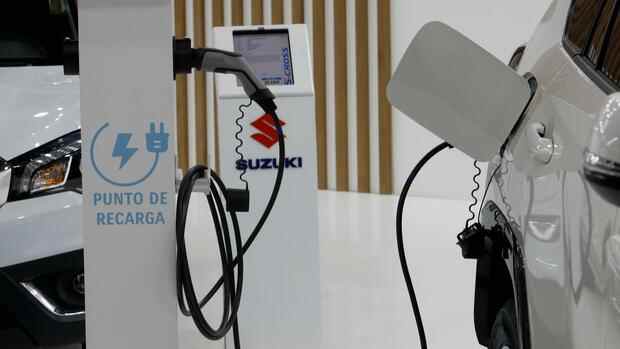Semiconductors made of silicon carbide are often used in electric cars and charging stations.
(Photo: dpa)
Munich Gregg Lowe attacks, and that is to be taken literally: The American chip manufacturer Wolfspeed has been listed on the New York Stock Exchange for a few days under the abbreviation “WOLF”. The CEO gives up the previous name Cree with the move from the Nasdaq computer stock exchange to Wall Street.
The renaming is also accompanied by a radical realignment. Lowe sold the last remainder of the traditional lighting technology business last year. Now the manager is completely focused on semiconductors.
But not just any: Wolfspeed is the world market leader in silicon carbide (SiC) chips. The material is more expensive than conventional silicon, but it is particularly promising in electromobility.
With chips made of silicon carbide, electric vehicles achieve greater ranges, can be charged more quickly, and all of this at lower costs with less space and less weight. One of the best-known buyers is the German auto supplier ZF. At the beginning of this week, the Americans also signed a long-term supply contract with General Motors.
Top jobs of the day
Find the best jobs now and
be notified by email.
Wolfspeed is currently expanding its capacities by a factor of 30 with a new plant in the US state of New York. It should go into operation next spring. “With our factory, we will be launched on the market at exactly the right time in early 2022,” Lowe told Handelsblatt. Semiconductors are scarce worldwide and manufacturers have not been able to keep up with the order boom for months.
The purchase would have been worth it for Infineon
The group also produces silicon carbide for other chip manufacturers as the raw material for their components. Major customers include the Dax group Infineon, but also ST Microelectronics and Onsemi.
Because of the seminal material, Infineon boss Reinhard Ploss intended to buy the company five years ago. According to its own statements, Wolfspeed has a global market share of 60 percent for SiC chips. It would have been a brilliant deal for Infineon. Europe’s largest chip manufacturer wanted to shell out $ 850 million. However, the US authorities prohibited the takeover on the grounds of national security. Wolfspeed is now worth more than nine billion dollars on the stock exchange and supplies, among other things, the US military.
The American has been running Wolfspeed since autumn 2017 and is currently building a new chip factory in the USA.
(Photo: Cree)
The North Carolina company is small compared to other semiconductor manufacturers. In the past fiscal year, which ended on June 27, sales from continuing operations climbed twelve percent to $ 526 million (around 453 million euros). In comparison: Infineon generates six times as much sales in one quarter as Wolfspeed in the whole year. The bottom line was a loss of almost the same amount.
The main reason for the deep red numbers is the high level of investment, according to Lowe. That will change with the new factory. At the moment, in-house production is too small and therefore too expensive. However, investors are skeptical. The course has more than doubled since the electrical engineer Lowe took the executive chair in the fall of 2017. Since the beginning of the year, however, the company has lost around 30 percent of its value.
The prospects are bright, so Lowe: The manager promises to triple his business by 2024. Demand is picking up vigorously: Infineon, for example, assumes that the market for SiC chips will grow by 30 to 40 percent annually by the middle of the decade.
Wolfspeed is already planning the next plant – it could be in Germany
The fact that Wolfspeed is not growing much faster is due to the complex production process. “Despite their usefulness, SiC transistors still have to overcome a number of technical and economic hurdles,” says Amine Allouche, an analyst at System Plus Consulting. These included the price of the wafers and the complexity of some process steps. “These challenges still prevent the SiC application on a larger commercial scale.”
So far, SiC chips have mainly been used in charging stations, in photovoltaics and in industrial power supply. However, car manufacturers are now also increasingly using SiC for electric vehicles. “Simply by replacing silicon with silicon carbide, the range can be increased by eight percent,” says Peter Fintl, semiconductor expert at the technology consultancy Capgemini. Yole’s market researchers estimate that the SiC auto market will grow by an average of 38 percent each year to more than $ 1.5 billion through 2025.
Meanwhile, Lowe is already thinking ahead: “Before our new plant is finished, we are already in intensive discussions about the next factory.” Although no decision has yet been made about a location, it does not necessarily have to be the USA. “Europe is in a good position and quite competitive,” said the manager. He is also considering Germany.
More: In the wake of Infineon: Carinthia is attacking the chip industry
